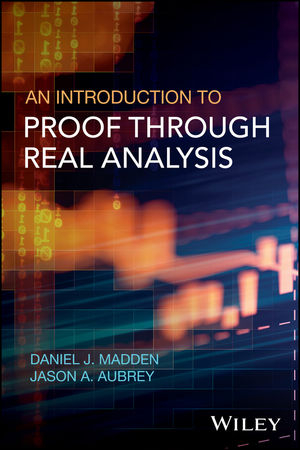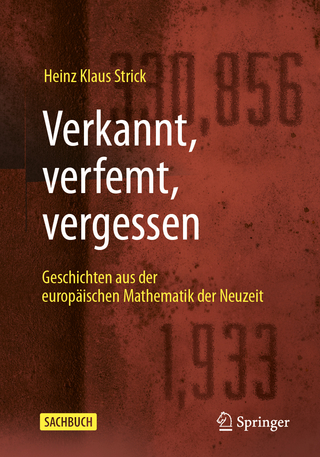
An Introduction to Proof through Real Analysis
John Wiley & Sons Inc (Verlag)
978-1-119-31472-1 (ISBN)
A mathematical proof is an inferential argument for a mathematical statement. Since the time of the ancient Greek mathematicians, the proof has been a cornerstone of the science of mathematics. The goal of this book is to help students learn to follow and understand the function and structure of mathematical proof and to produce proofs of their own.
An Introduction to Proof through Real Analysis is based on course material developed and refined over thirty years by Professor Daniel J. Madden and was designed to function as a complete text for both first proofs and first analysis courses. Written in an engaging and accessible narrative style, this book systematically covers the basic techniques of proof writing, beginning with real numbers and progressing to logic, set theory, topology, and continuity. The book proceeds from natural numbers to rational numbers in a familiar way, and justifies the need for a rigorous definition of real numbers. The mathematical climax of the story it tells is the Intermediate Value Theorem, which justifies the notion that the real numbers are sufficient for solving all geometric problems.
• Concentrates solely on designing proofs by placing instruction on proof writing on top of discussions of specific mathematical subjects
• Departs from traditional guides to proofs by incorporating elements of both real analysis and algebraic representation
• Written in an engaging narrative style to tell the story of proof and its meaning, function, and construction
• Uses a particular mathematical idea as the focus of each type of proof presented
• Developed from material that has been class-tested and fine-tuned over thirty years in university introductory courses
An Introduction to Proof through Real Analysis is the ideal introductory text to proofs for second and third-year undergraduate mathematics students, especially those who have completed a calculus sequence, students learning real analysis for the first time, and those learning proofs for the first time.
Daniel J. Madden, PhD, is an Associate Professor of Mathematics at The University of Arizona, Tucson, Arizona, USA. He has taught a junior level course introducing students to the idea of a rigorous proof based on real analysis almost every semester since 1990. Dr. Madden is the winner of the 2015 Southwest Section of the Mathematical Association of America Distinguished Teacher Award.
Jason A. Aubrey, PhD, is Assistant Professor of Mathematics and Director, Mathematics Center of the University of Arizona.
Daniel J. Madden, PhD, is an Associate Professor of Mathematics at The University of Arizona, Tucson, Arizona, USA. He has taught a junior level course introducing students to the idea of a rigorous proof based on real analysis almost every semester since 1990. Dr. Madden is the winner of the 2015 Southwest Section of the Mathematical Association of America Distinguished Teacher Award. Jason A. Aubrey, PhD, is Assistant Professor of Mathematics and Director, Mathematics Center of the University of Arizona.
List of Figures xiii
Preface xv
Introduction xvii
Part I A First Pass at Defining ℝ 97
1 Beginnings 3
1.1 A naive approach to the natural numbers 3
1.1.1 Preschool: foundations of the natural numbers 3
1.1.2 Kindergarten: addition and subtraction 5
1.1.3 Grade school: multiplication and division 8
1.1.4 Natural numbers: basic properties and theorems 11
1.2 First steps in proof 12
1.2.1 A direct proof 12
1.2.2 Mathematical induction 14
1.3 Problems 17
2 The Algebra of the Natural Numbers 19
2.1 A more sophisticated look at the basics 19
2.1.1 An algebraic approach 21
2.2 Mathematical induction 22
2.2.1 The theorem of induction 24
2.3 Division 27
2.3.1 The division algorithm 27
2.3.2 Odds and evens 30
2.4 Problems 34
3 Integers 37
3.1 The algebraic properties of ℕ 37
3.1.1 The algebraic definition of the integers 40
3.1.2 Simple results about integers 42
3.1.3 The relationship between ℕ and ℤ 45
3.2 Problems 47
4 Rational Numbers 49
4.1 The algebra 49
4.1.1 Surveying the algebraic properties of ℤ 49
4.1.2 Defining an ordered field 50
4.1.3 Properties of ordered fields 51
4.2 Fractions versus rational numbers 53
4.2.1 In some ways they are different 53
4.2.2 In some ways they are the same 56
4.3 The rational numbers 58
4.3.1 Operations are well defined 58
4.3.2 ℚ is an ordered field 63
4.4 The rational numbers are not enough 67
4.4.1 √2 is irrational 67
4.5 Problems 70
5 Ordered Fields 73
5.1 Other ordered fields 73
5.2 Properties of ordered fields 74
5.2.1 The average theorem 74
5.2.2 Absolute values 75
5.2.3 Picturing number systems 78
5.3 Problems 79
6 The Real Numbers 81
6.1 Completeness 81
6.1.1 Greatest lower bounds 81
6.1.2 So what is complete? 82
6.1.3 An alternate version of completeness 84
6.2 Gaps and caps 86
6.2.1 The Archimedean principle 86
6.2.2 The density theorem 87
6.3 Problems 90
6.4 Appendix 93
Part II Logic, Sets, and Other Basics 97
7 Logic 99
7.1 Propositional logic 99
7.1.1 Logical statements 99
7.1.2 Logical connectives 100
7.1.3 Logical equivalence 104
7.2 Implication 105
7.3 Quantifiers 107
7.3.1 Specification 108
7.3.2 Existence 108
7.3.3 Universal 109
7.3.4 Multiple quantifiers 110
7.4 An application to mathematical definitions 111
7.5 Logic versus English 114
7.6 Problems 116
7.7 Epilogue 118
8 Advice for Constructing Proofs 121
8.1 The structure of a proof 121
8.1.1 Syllogisms 121
8.1.2 The outline of a proof 123
8.2 Methods of proof 127
8.2.1 Direct methods 127
8.2.1.1 Understand how to start 127
8.2.1.2 Parsing logical statements 129
8.2.1.3 Mathematical statements to be proved 131
8.2.1.4 Mathematical statements that are assumed to be true 135
8.2.1.5 What do we know and what do we want? 138
8.2.1.6 Construction of a direct proof 138
8.2.1.7 Compound hypothesis and conclusions 139
8.2.2 Alternate methods of proof 139
8.2.2.1 Contrapositive 139
8.2.2.2 Contradiction 142
8.3 An example of a complicated proof 145
8.4 Problems 149
9 Sets 151
9.1 Defining sets 151
9.2 Starting definitions 153
9.3 Set operations 154
9.3.1 Families of sets 157
9.4 Special sets 160
9.4.1 The empty set 160
9.4.2 Intervals 162
9.5 Problems 168
9.6 Epilogue 171
10 Relations 175
10.1 Ordered pairs 175
10.1.1 Relations between and on sets 176
10.2 A total order on a set 179
10.2.1 Definition 179
10.2.2 Definitions that use a total order 179
10.3 Equivalence relations 182
10.3.1 Definitions 182
10.3.2 Equivalence classes 184
10.3.3 Equivalence partitions 185
10.3.3.1 Well defined 187
10.4 Problems 188
11 Functions 193
11.1 Definitions 193
11.1.1 Preliminary ideas 193
11.1.2 The technical definition 194
11.1.2.1 A word about notation 197
11.2 Visualizing functions 202
11.2.1 Graphs in ℝ2 202
11.2.2 Tables and arrow graphs 202
11.2.3 Generic functions 203
11.3 Composition 204
11.3.1 Definitions and basic results 204
11.4 Inverses 206
11.5 Problems 210
12 Images and preimages 215
12.1 Functions acting on sets 215
12.1.1 Definition of image 215
12.1.2 Examples 217
12.1.3 Definition of preimage 218
12.1.4 Examples 220
12.2 Theorems about images and preimages 222
12.2.1 Basics 222
12.2.2 Unions and intersections 228
12.3 Problems 231
13 Final Basic Notions 235
13.1 Binary operations 235
13.2 Finite and infinite sets 236
13.2.1 Objectives of this discussion 236
13.2.2 Why the fuss? 237
13.2.3 Finite sets 239
13.2.4 Intuitive properties of infinite sets 240
13.2.5 Counting finite sets 241
13.2.6 Finite sets in a set with a total order 243
13.3 Summary 246
13.4 Problems 246
13.5 Appendix 248
13.6 Epilogue 257
Part III A Second Pass at Defining ℝ 261
14 ℕ, ℤ, and ℚ 263
14.0.1 Basic properties of the natural numbers 263
14.0.2 Theorems about the natural numbers 266
14.1 The integers 267
14.1.1 An algebraic definition 267
14.1.2 Results about the integers 268
14.1.3 The relationship between natural numbers and integers 270
14.2 The rational numbers 272
14.3 Problems 279
15 Ordered Fields and the Real Numbers 281
15.1 Ordered fields 281
15.2 The real numbers 284
15.3 Problems 289
15.4 Epilogue 290
15.4.1 Constructing the real numbers 290
16 Topology 293
16.1 Introduction 293
16.1.1 Preliminaries 293
16.1.2 Neighborhoods 295
16.1.3 Interior, exterior, and boundary 298
16.1.4 Isolated points and accumulation points 300
16.1.5 The closure 303
16.2 Examples 305
16.3 Open and closed sets 311
16.3.1 Definitions 311
16.3.2 Examples 315
16.4 Problems 316
17 Theorems in Topology 319
17.1 Summary of basic topology 319
17.2 New results 321
17.2.1 Unions and intersections 321
17.2.2 Open intervals are open 325
17.2.3 Open subsets are in the interior 327
17.2.4 Topology and completeness 328
17.3 Accumulation points 329
17.3.1 Accumulation points are aptly named 329
17.3.2 For all A ⊆ ℝ, A′ is closed 333
17.4 Problems 341
18 Compact Sets 345
18.1 Closed and bounded sets 345
18.1.1 Maximums and minimums 345
18.2 Closed intervals are special 354
18.3 Problems 356
19 Continuous Functions 359
19.1 First semester calculus 359
19.1.1 An intuitive idea of a continuous function 359
19.1.2 The calculus definition of continuity 360
19.1.3 The official mathematical definition of continuity 363
19.1.4 Examples 364
19.2 Theorems about continuity 374
19.2.1 Three specific functions 374
19.2.2 Multiplying a continuous function by a constant 377
19.2.3 Adding continuous functions 378
19.2.4 Multiplying continuous functions 379
19.2.5 Polynomial functions 382
19.2.6 Composition of continuous functions 382
19.2.7 Dividing continuous functions 384
19.2.8 Gluing functions together 385
19.3 Problems 386
20 Continuity and Topology 389
20.1 Preliminaries 389
20.1.1 Continuous images mess up topology 389
20.2 The topological definitions of continuity 391
20.3 Compact images 397
20.3.1 The main theorem 397
20.3.2 The extreme value theorem 400
20.3.3 The intermediate value theorem 401
20.4 Problems 404
21 A Few Final Observations 407
21.1 Inverses of continuous functions 407
21.1.1 A strange example 408
21.1.2 The theorem about inverses of continuous functions 409
21.2 The intermediate value theorem and continuity 412
21.3 Continuity at discrete points 413
21.4 Conclusion 413
Index 415
| Erscheinungsdatum | 20.10.2017 |
|---|---|
| Verlagsort | New York |
| Sprache | englisch |
| Maße | 165 x 236 mm |
| Gewicht | 703 g |
| Themenwelt | Schulbuch / Wörterbuch |
| Mathematik / Informatik ► Mathematik ► Allgemeines / Lexika | |
| Mathematik / Informatik ► Mathematik ► Analysis | |
| Sozialwissenschaften ► Pädagogik | |
| ISBN-10 | 1-119-31472-0 / 1119314720 |
| ISBN-13 | 978-1-119-31472-1 / 9781119314721 |
| Zustand | Neuware |
| Haben Sie eine Frage zum Produkt? |
aus dem Bereich


